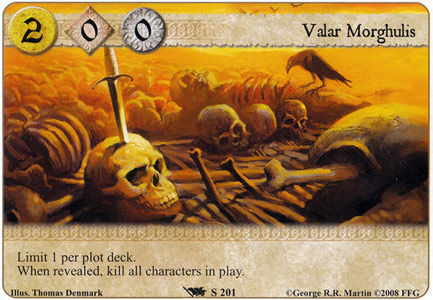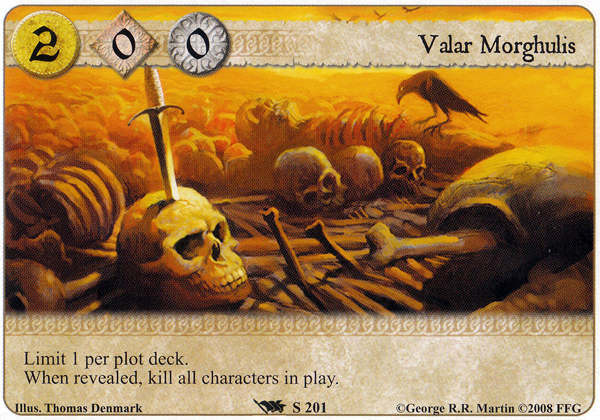Welcome to Card Game DB
Register now to gain access to all of our features. Once registered and logged in, you will be able to create topics, post replies to existing threads, give reputation to your fellow members, get your own private messenger, post status updates, manage your profile and so much more. If you already have an account, login here - otherwise create an account for free today!
Register now to gain access to all of our features. Once registered and logged in, you will be able to create topics, post replies to existing threads, give reputation to your fellow members, get your own private messenger, post status updates, manage your profile and so much more. If you already have an account, login here - otherwise create an account for free today!
Crafting The Theory - All Men Must Die
Jun 19 2012 05:34 PM |
Kennon
in Game of Thrones
Small Council Crafting The Theory Kennon So, ask anyone who’s been playing A Game of Thrones for some time what the most defining card in the history of the game (both CCG and LCG) is.
So, ask anyone who’s been playing A Game of Thrones for some time what the most defining card in the history of the game (both CCG and LCG) is.Ok, are you back? What did they say?
If they said anything other than this card, you might need to tell them that they’re wrong.

Barring a brief experiment during Winter Edition of the CCG, Valar Morghulis has been a staple of the card pool since the second set released for the game way back in 2002. That means it debuted nearly a decade ago in Sea of Storms. The list of cards that have enjoyed that level of longevity is extremely short, and none of the others that come close on longevity come close on level of influence on the game. For years Valar Morghulis has been used as a balancing factor and presure valve for the environment at large as well as a baseline and measurement for which to design cards.
In order to understand how Valar Morghulis is so influential, we’ll need to analyze the three different aspects of its play. The three basic uses of Valar Morghulis are:
- Generate Card Advantage
- Buy Time
- Kill a Character
The base level use is to kill a character. More often than not, this will be more than one character, but people should never overlook the capability to snipe out a single game altering character if circumstances call for it. If your opponent was a little too overzealous in their setup, for example, you eliminate King Viserys before any saves are in place and completely destroy their deck. Likewise, as the game progresses, there may very well be an opportunity to use Nightmares on the opponent’s Beric Dondarrion to make him vulnerable and use Valar to kill him while your opponent doesn’t have the chance to stop it. This most straightforward play is probably the one that the majority of players are most likely to overlook. Being the base level option, many players will overthink the ramification on their own cards and characters in the attempt to be strategic, and skip over what might be the correct tactical play at that exact moment regardless of what characters may be lost on their own side of the board.
Buying time is a middle ground play in that it opens you up to future tactical or strategic plays. If we look at the basic measurement of time in AGoT as a round or turn, then any action that buys you time is buying you some number of turns. Turns are important because of the large but finite number of plays that are available to a player during the course of those turns. For instance, on the average turn, your plays are generally any variable number from zero up to some combination of resources available/ the cards in your hand + cards in play(And yes, I’m dropping that formula off the top of my head for a ballpark reference. Maybe sometime we’ll get some guest help for the column and work out an actual formula). However vague and inaccurate my test formula might be, it does at least serve to illustrate an important factor. By the default rules of the game, you draw addition cards and gain fresh resources by the framework each turn. This means that the more turns that the game goes on, the more aggregate options that you will eventually have. In this instance, Valar Morghulis is being used to generate additional time for you in order to expand your options. The more of these options you have, the more opportunities there are to either neutralize your opponent’s plan or to enact your own. Depending on what the particular options that become available to you then, dictate whether the time that you’ve bough is best used for tactical or strategic play.
The number one option on our list, however, is strict card advantage. This is the level of use that the majority of players will be most familiar with. For a many players, the overall game of AGoT can be broken down largely into a system of Cards In- Cards Out. As long as the resulting number is positive in any given situation, you have gained card advantage. Over the course of a game, the player who is most likely to win is the player whose cards have most efficiently generated the larger amount of card advantage, which leads to a longer, more strategic playstyle. Valar Morghulis is most frequently used in this manner in order to punish players who have overextended with a large number of characters on the board. If you reveal Valar Morghulis and kill one of your own characters, but 5 of the opponent’s, then you have effectively spent 2 cards in order to eliminate 5 for a difference of 3 in your favor. Some of you may also note that this situation most likely generates board advantage for you as well, but that’s a topic for an entirely different entry in the column.
Speaking of different entries in the column, join me next time as we take a look at what Valar Morghulis does to the opponent rather than just what it does for you!
- mischraum and Laxen like this



 Sign In
Sign In Create Account
Create Account












8 Comments
And if I did, as a Baratheon player I try to work around it.
Ser Parmen plus lords and enough influence is my go to (Or Dupes). Maybe narrow escape.
On the other hand when Greyjoy becomes too popular in my meta I love to play Wildfire so they can put their saves into a place where even Renly couldn't find them.